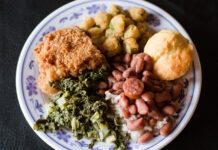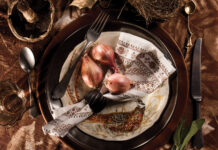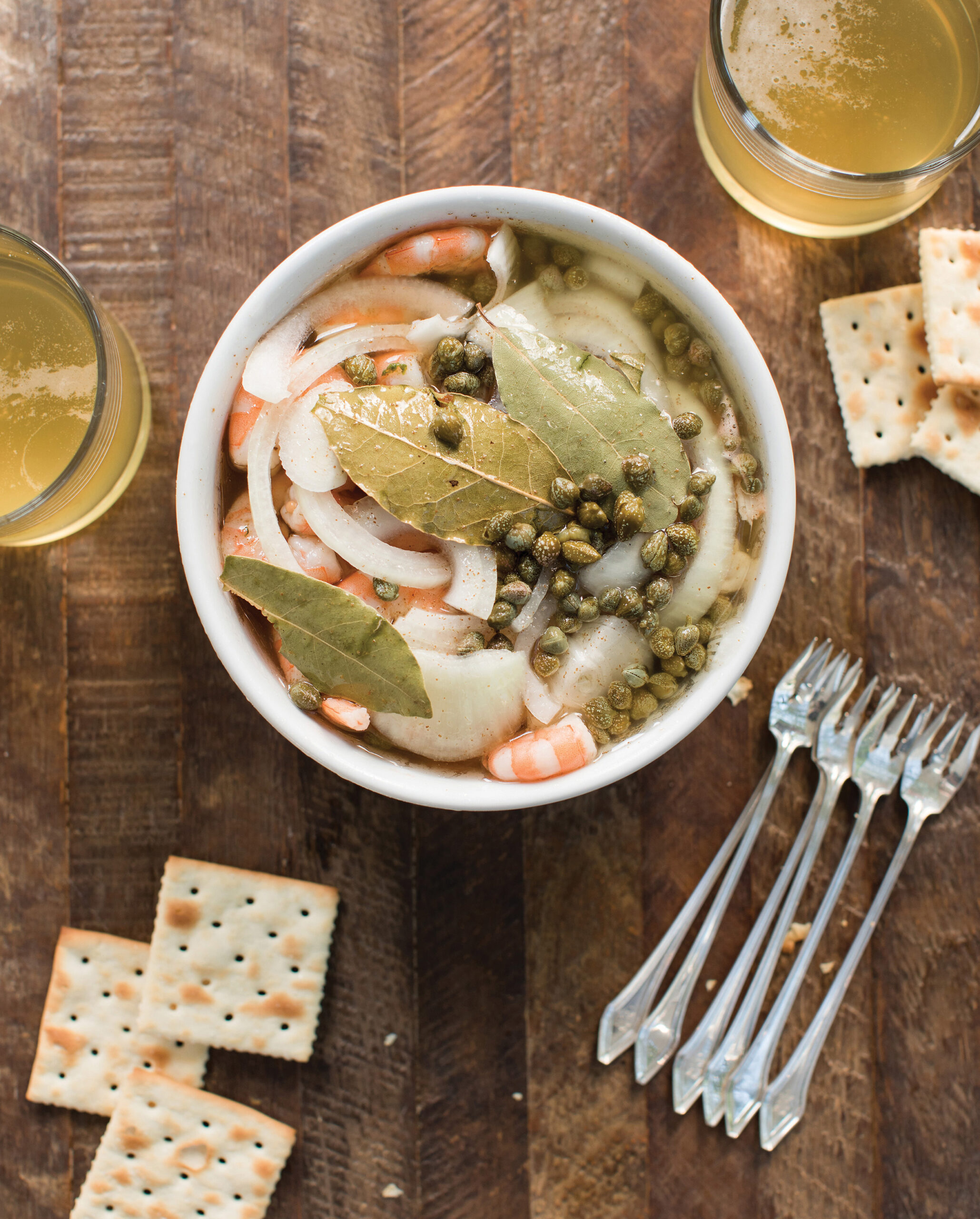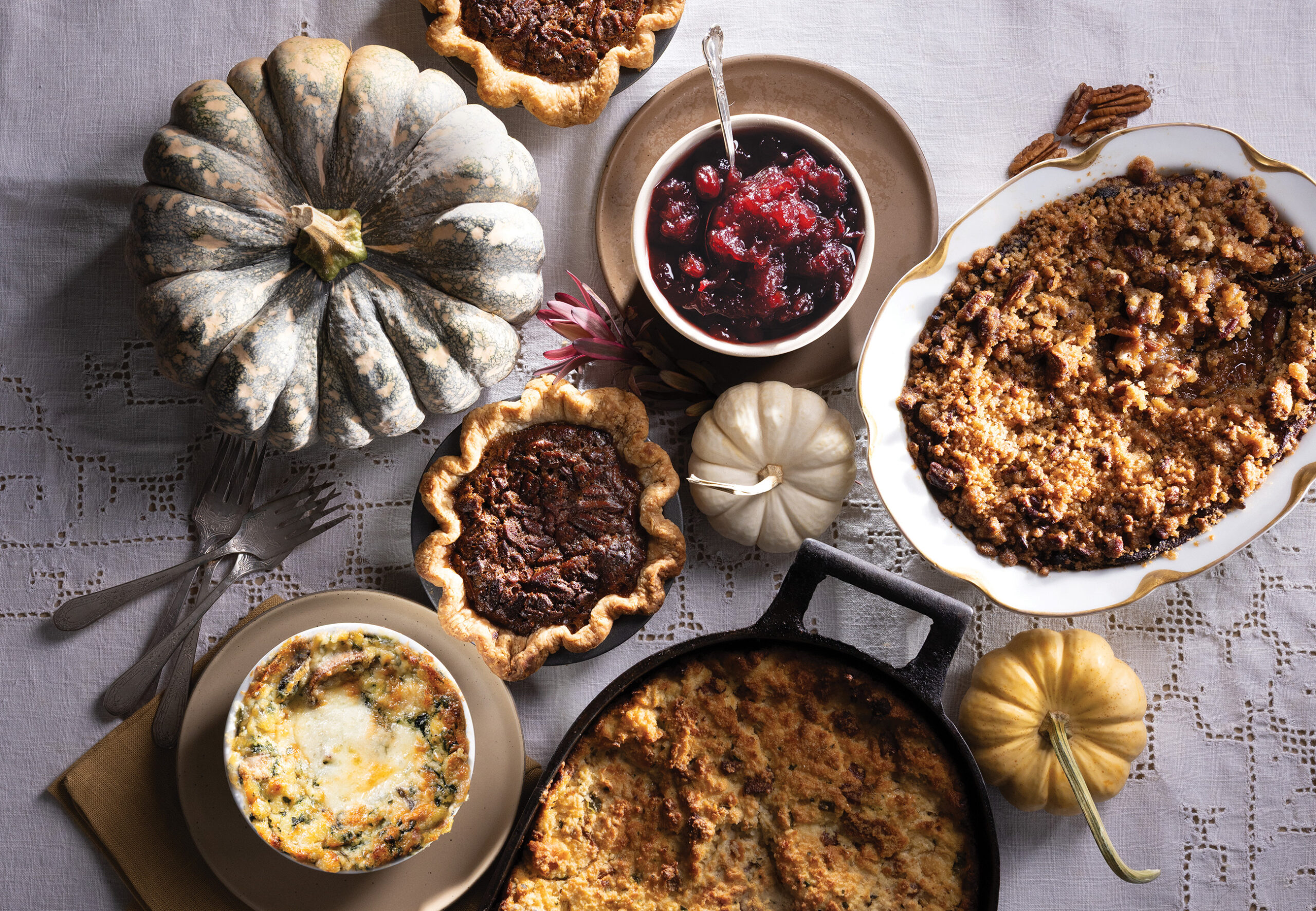
The holidays bring people together, and for chefs, food is at the core of seasonal celebrations. For them, longstanding customs and vivid memories are anchored in what happens around the dinner table. We spoke with three local culinarians about the holiday dishes they hold most dear, the family practices that inspired them and the way inherited traditions live on in their kitchens. Their stories are a reminder that holiday cooking is as much about moments that linger long after the meal is over as the menu is.
Caitlin Horne

The Fairhope Inn • thefairhopeinn.com
Chef Caitlin Horne of the Fairhope Inn grew up in a household that loved a maximalist Thanksgiving. With her family’s open-door policy and lengthy guest list, they had no choice but to go big during the holidays, especially when it came to food. The spirit of hospitality and abundance instilled in her at an early age motivates her today every time she sets a table, plates a dish or invites someone over to dinner.
Horne’s family’s holiday traditions set the stage for how she approaches food and entertaining today. “Our house was the place to be at for Thanksgiving and Christmas,” she says. “Dad always did the turkey. We always had a roasted one, and he would smoke about 10 of them before the holidays to give as gifts. Our best family friends would bring over a fried turkey. Mom’s big thing was desserts — she’s an excellent pie maker. I kind of took over the sides.”
Horne staked her claim in the kitchen, taking on her self-appointed role as her family’s holiday side dish specialist. “From a really young age, I started doing the mashed potatoes and gravy, helping my dad with the oyster dressing and collard greens,” she says. “One of my favorites was my mom’s spinach bread pudding. She was always coming up with fun side dishes, and this one had spinach, garlic, gruyere — all the good stuff. Then one year, my sister brought it over and she had added sauteed mushrooms to it, and we wondered why we hadn’t been doing it like that forever!”
The confidence she brings to the table today was stoked by the support of her parents and their encouragement of her playing with her food. “I wanted to cook as soon as I could use my hands. I was in the highchair rolling pie crust,” Horne says. “I think the most courageous and confident I’ve ever been in my life has been in the kitchen, and my parents definitely facilitated that from a very young age. Anything that I saw that I wanted, they’d go out and find it for me, and they really encouraged me to go after it. I’ve always gone with my gut and my palate in the kitchen, and for the most part, I’ve been successful. It’s been important to have that support system, and they were interested in it, and they’re proud of me for doing it.”
Horne’s holiday season looks a little different this year. With her family now spread out across the country and her mother leaving town for Thanksgiving, she’ll be sporting her chef whites at the Fairhope Inn and celebrating with friends after closing.
“We’re gonna do a Friendsgiving with the people at the restaurant. I’ve never been to one before,” she says. “My parents opened up our home during the holidays. We were a catch-all for the people that didn’t have a place to go. We’re all more spread out now, and holidays are a lot smaller. But doing this Friendsgiving — I can’t imagine spending a holiday without close friends or family. Having this sense of community and a time to actually sit and appreciate each other and share a meal together is special and something that often gets overlooked.”
For Horne, keeping open seats at the table and being grateful for the people in her life are practices to be observed throughout the year. “I live by myself now, but I always want anybody who wants to come to my table when I cook or grill out to feel welcome to. I always take food to my neighbors when I have extra. It’s the best way that I can show that I love and care for other people. There are some things I can’t do, but I can definitely feed you, and that’s my philosophy on taking care of people.”
Caitlin’s Brown Butter Pecan Pie

MAKES TWO 5-INCH PIES OR ONE 9-INCH PIE
Crust
1/2 pounds unsalted butter, cubed and frozen
2 1/2 cups all-purpose flour
1/2 teaspoon salt
1/2 – 3/4 cup ice water
Filling
1 heaping cup chopped pecans
1/3 cup butter
3 tablespoons non-fat dry milk powder
3 eggs, beaten
1/2 cup light corn syrup
1/2 cup dark corn syrup
1 cup dark brown sugar
1 teaspoon vanilla bean paste
1/2 teaspoon salt
For the Crust
1. Toss butter cubes in flour to coat, then place flour, butter and salt in a food processor and pulse until the butter is the size of small beads.
2. While food processor is running drizzle ice water into the butter and flour. Mix until the dough rises up the sides and begins to fall back into the center.
3. Turn the dough out of the mixer into a bowl and, using your hands, press the dough into a ball. Use the warmth of your hands to press the remaining bits of butter and flour together. Work quickly to prevent butter from melting into the flour. Wrap in plastic wrap and chill for 30 minutes.
4. Divide dough in half and roll out onto a generously floured surface until 1/4 inch thick. Carefully roll dough into your pie tin and tuck excess under the lip of the tin. Use the knuckle and forefinger thumb of both hands to flute the edges.
For the Filling
1. Preheat oven to 300 degrees. Toast pecans on a baking sheet for 7 minutes, then remove from oven and allow to cool. Increase oven temperature to 425 degrees.
2. Melt butter in a saucepan with the powdered milk. Stir with a whisk over medium heat for about 5 minutes or until the butter browns.
3. Transfer melted butter to a large bowl and add all remaining ingredients and whisk until emulsified. Stir in toasted pecans and pour into unbaked pie shell.
4. Bake for 10 minutes. Reduce heat to 400 degrees and bake for another 15 minutes. Reduce heat to 350 and bake for another 20 minutes.
5. Remove from oven and allow to cool completely, at least 4 hours before cutting.
Cook’s note: The milk powder will create more brown butter solids for and extra nutty brown butter kick in your pie filling. This step is not necessary but delicious.
Spinach and Mushroom Bread Pudding
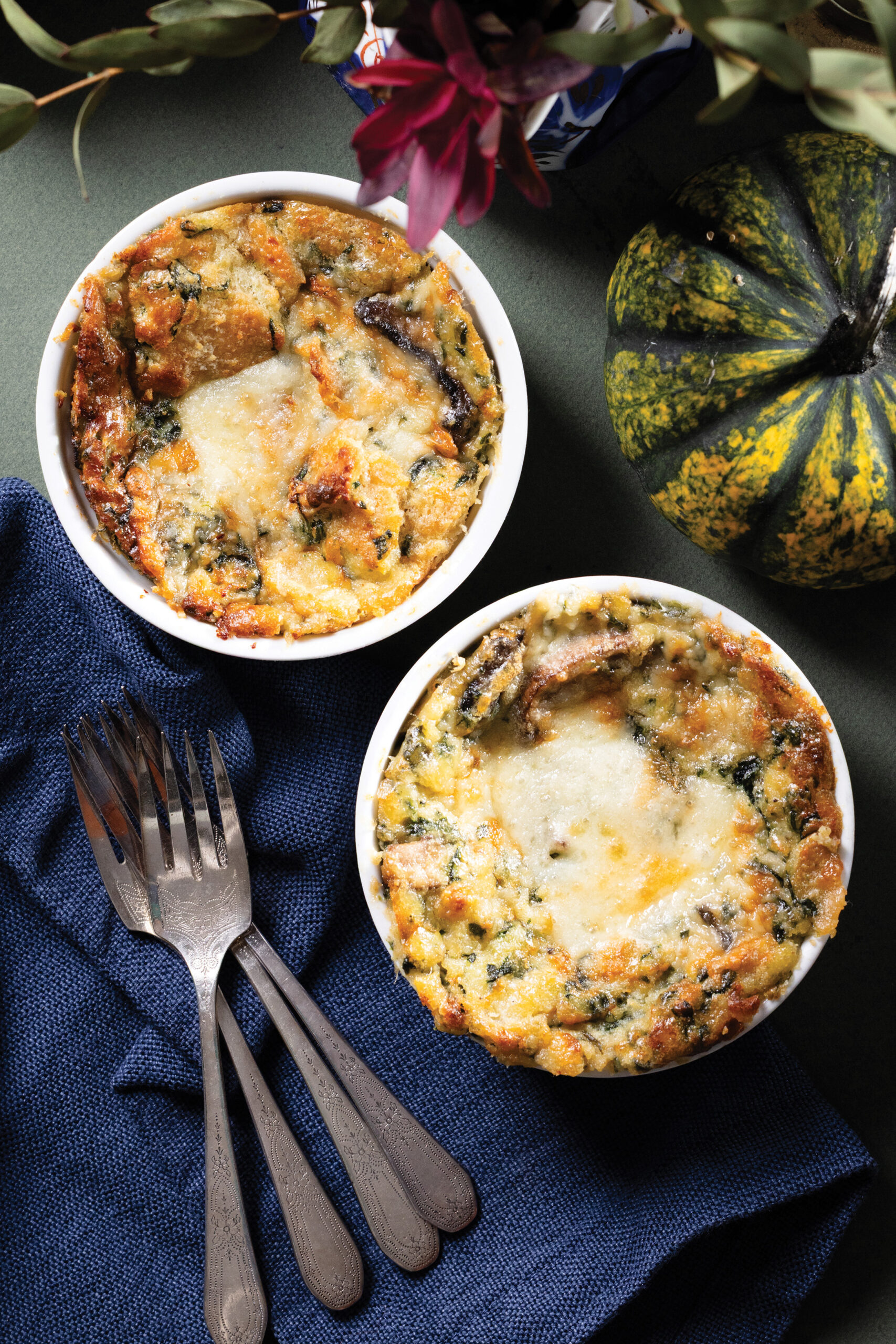
SERVES 6 – 8
Ingredients
5 cups French bread, torn into bite-sized chunks
olive oil, for sauteing
4 cups sliced cremini or button mushrooms
1 8-ounce bag of spinach
1/3 cup butter, melted
1/4 cup garlic, chopped
4 eggs
2 cups half and half
2 cups heavy cream
2 teaspoons salt
1/2 teaspoon white pepper
dash of grated nutmeg
4 cups white cheddar cheese, grated and divided
Directions
1. Preheat oven to 300 degrees. Spread bread chunks evenly onto a sheet pan and bake for about 10 minutes, being careful only to dry the bread without browning it. Remove from oven and increase temperature to 375 degrees.
2. Sautee mushrooms in olive oil over medium high heat, tossing occasionally until browned. Remove from pan and set aside.
3. In the same pan, pour 2 – 3 more teaspoons of olive oil. Add spinach and cover, stirring occasionally, until wilted. Remove from pan and drain excess liquid. Allow to cool and then chop. Set aside.
4. In the same pan, add the melted butter and garlic, cooking over medium heat for 1 – 2 minutes or until fragrant, being careful to not brown the garlic.
5. In a large mixing bowl, beat eggs, half and half, cream, salt, pepper and nutmeg. Add the bread and toss. Allow to sit for about 10 minutes for the dried bread to absorb the custard.
6. Once the bread is soggy and you cannot feel any toasty bits, add cooled mushrooms, spinach and buttered garlic. Add 3 cups of cheese to the bowl and carefully fold into the mixture.
7. Pour mixture into one large or two small buttered casseroles, tent with foil and bake for 20 minutes. Uncover and top with remaining cup of cheese and let bake for an additional 10 minutes. Allow bread pudding to rest for 15 minutes before serving.
Sally Stringfellow

Sallie • salliefairhope.com
Chef Sally Stringfellow learned at an early age that food, from farm to table, is inseparably braided with traditions and the people that make them. Her childhood spent in bucolic north Alabama exposed her to the beauty of food even in its simplest forms, and lessons from her family about tenacity, learned from growing and canning food to survive the hardships of the Great Depression, continue to shape her approach to cooking today. Today, as a classically trained private chef, she brings those same values into her restaurant and catering to help others celebrate life’s most intimate moments.
When Stringfellow reflects on her philosophies about food, she often begins with her grandmothers and the lessons she learned while growing up on a rural dairy farm. “A lot of things that I learned about cooking were from my grandmothers,” she says. “Both of them grew up during the Great Depression, and one of them had a 10-acre garden that she worked in even in her 80s. She knew all about canning because, at one point in her life, she had to do it to make sure she had something to eat. We put everything up. We made soups and canned everything. I learned so much about fresh food from her. I think being a part of raising your own food or gardening and preserving is such a beautiful thing because it fosters interest in food in one way or another, even if it’s just to give the body what it needs in its purest form.”
Each of Stringfellow’s grandmothers passed down lessons in flavor and resourcefulness in her own way. “My maternal grandmother was an excellent cook. It was all seasonal,” she says. “I remember when the apples came and they’d fall and she couldn’t mow her yard, we’d go out there and pick up all the apples so we could mow. And after we’d come in, she would always have this big bowl of warm apple sauce for us. I remember we had her special cornbread dressing at Thanksgiving. My paternal grandmother? Well, she liked to add different stuff to hers like eggs. Chicken, too. That’s not really what people put in dressing, but that’s what she did. Growing up during the Depression, you didn’t go out and buy a big turkey, but you could maybe have some dressing with chicken in it. And I so admire her for everything she had to overcome.”
Stringfellow eventually shifted from learning family traditions into creating them, especially in ways that connected her to her community. “Years ago, I was just cooking for random people because I was raising my kids and wanted to focus on that instead of a full-time job,” she says. “People would ask me to make specific stuff, and I’d do it. For a long time, when it came to the holidays, I just did a menu and put everything on there that I knew people would want. It was a lot! They would order their whole Thanksgiving meals from me. But that has been such a gift. I got to learn from people here in this community and about their traditions, and I’ve gotten to be a part of them, which is amazing.”
Stringfellow largely credits her neighbors with being a steady source of encouragement throughout her culinary journey. “I’ve been through some hard times, and I’ve had these people around me investing in me saying, ‘We’re going to get you through this,’” she says. “They look out for me when they know I’ll love something from an estate sale, and a precious lady in the community is the reason I have this building. It wasn’t really on the market yet, but she knew I had been looking for a place and called me to tell me I should go see it. I have all these wonderful people around me that have blessed me in so many ways.”
The kitchen has become Stringfellow’s way of showing her gratitude and love for the people around her. “I’ve always wanted to entertain, but I don’t like being the front-and-center hostess. I always just want to be in the back and see everybody having a good time,” she says. “I get to cook for intimate events at people’s houses and here in my kitchen, and I get to be a part of their traditions and lives. That’s what makes me happier than anything. It’s what I love to do.”
Sally’s Sweet Potato Souffle

SERVES 6
Filling Ingredients
1/2 cup butter softened
2 eggs, yolks and whites, separated
1 teaspoon vanilla extract
2/3 cup granulated sugar
1/3 cup milk
3 cups cooked sweet potato
Topping Ingredients
1/3 cup melted butter
1 cup brown sugar
1/4 cup flour
1 cup chopped pecans
Directions
1. Butter a 9×13 pan. Set aside. Preheat oven to 350 degrees.
2. In a food processor add butter, egg yolks, vanilla, granulated sugar, milk and sweet potatoes. Blend until smooth and combined.
3. In a cold mixing bowl whip together egg whites to a soft peak. Gently fold egg whites into sweet potato mixture.
4. To make topping, combine ingredients in a bowl and mix well. Crumble over sweet potatoes and bake for
30 minutes.
Cook’s note: Sally bakes whole sweet potatoes at 350 degrees for one hour until baked through. Allow to cool, then peel and mash flesh.
Jim Smith
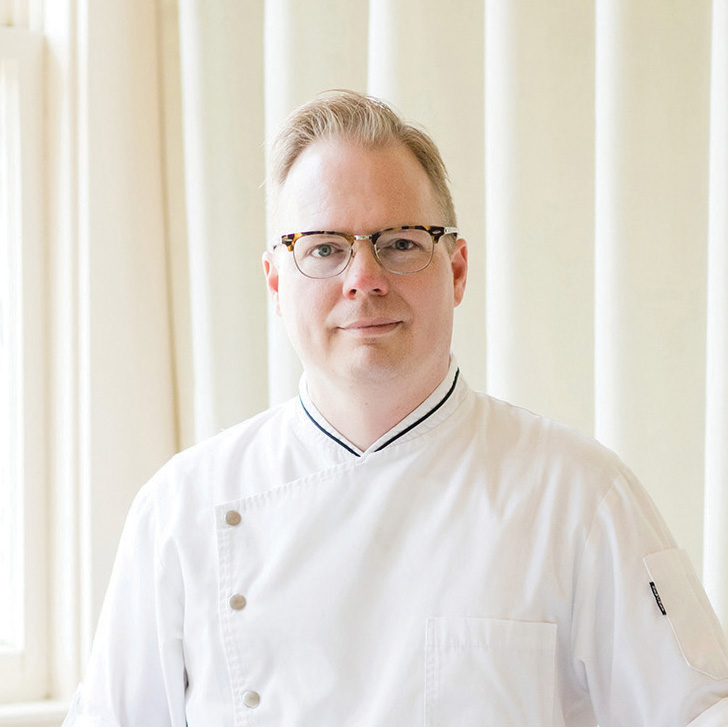
The Hummingbird Way • thehummingbirdway.com
Chef Jim Smith has a reputation as one of Alabama’s most accomplished chefs, from his tenure as executive chef of the State of Alabama to his title as “King of American Seafood.” Yet, when the holidays roll around, the man behind The Hummingbird Way trades his place in the kitchen for a seat at the family table. It’s a rare chance to slow down and enjoy the kind of meal that made him fall in love with cooking in the first place.
The holiday gatherings from Smith’s childhood are familiar to many. While they look a bit different now, his family still tries to honor the ritual of getting together. “Usually for Thanksgiving and Christmas, we would have some sort of big family get-together where relatives from all over would have a chance to gather and enjoy each other’s company,” he says. “For the most part, my parents, my brother and I still get together when we can. Things have changed a little bit over time just because people live in different areas. People get married and have kids and move to different places, but that’s the way life is. But we still do our best to make Thanksgiving special.”
Though holiday rites have evolved over time, some things about Smith’s family gatherings are comfortably familiar. “When we get together, it’s almost in the exact same kind of areas where we gathered when I was a child. In fact, a lot of times it’s the house next door to my grandmother’s old house,” he says. Smith’s grandmother oversaw the main parts of holiday meals, but each guest contributed their own specialty dishes every year. “Even though maybe the turkey and dressing and gravy all came from that central kitchen, people would bring the sides and desserts and other items that helped make the meal special.”
Smith’s grandmother was no stranger to cooking for a crowd, and her flavor mastery left a lasting impression on him. “I think a lot of chefs are probably trying to chase those food memories from when they were younger,” he says. “My grandmother was a lunchroom lady. When she was working, she made pies and other things from scratch for a high school. You wouldn’t really think of lunchroom workers doing that kind of stuff these days. And, for sure, the flavors that she had in her dressing are the flavors I like in mine. Even though I have a professional skill set, I’m still looking to try to find and replicate those flavors that I enjoy so much.”
As a chef that knows all too well that hosting holiday meals can be hectic, Smith likes to contribute items that are ready to enjoy. “I always try to show up with some dressing and some desserts and a cranberry sauce,” he says. “I like to make mine from scratch. There’s a debate whether canned or homemade is best, and really, I like both. But I just try to show up with stuff that’s ready to go.”
He knows first-hand that cooking for others is a lot of work, and he’s grateful for the opportunity for the tables to be turned. “There’s a misconception that when you cook for a chef, they’re doing to judge what you made. People can be intimidated,” Smith says. “But there’s an important balance there. It’s nice for me to have a break sometimes, and as long as you’re making things that you care about and it’s hot and well-seasoned, it’s very nice to eat food that other people make. I think that probably most chefs are going to enjoy what you put in front of them.”
Smith knows there’s comfort in the classics, but he also finds joy in trying new things. “Don’t be scared to try something new. You never know what might be your next family tradition,” he says. “For example, I’ve always wanted to go to the Poarch Creek Powwow that happens on Thanksgiving. It can be hard to get away from the spaces we’re used to, but sometimes it’s good to mix it up. Do a little research. Find out what’s good and in season near you. Add a new dish to your repertoire. Do something fun and interesting. Just don’t be afraid to try new things.”
Oyster Dressing
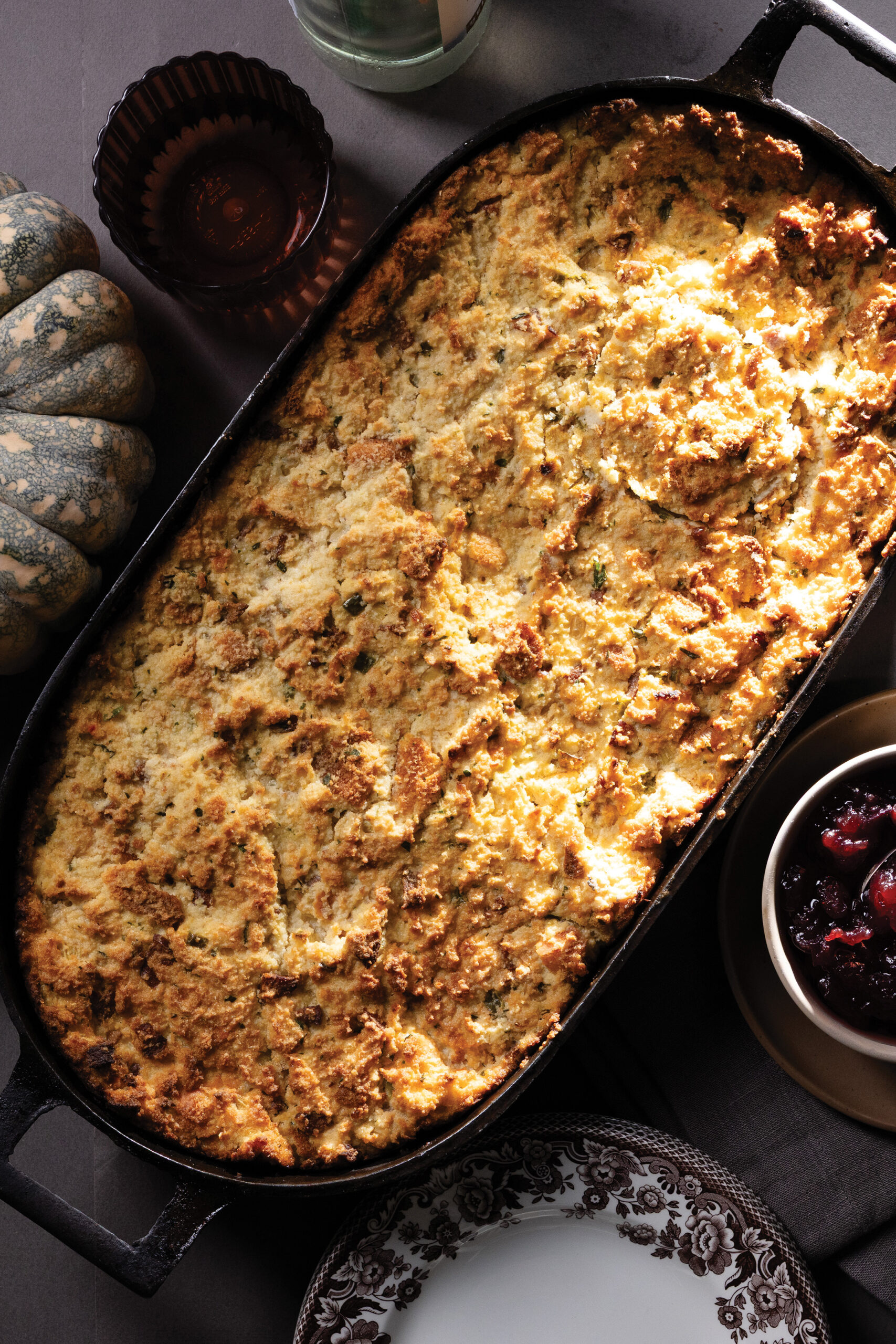
SERVES 8 – 10
Ingredients
1/2 pound Conecuh sausage, finely diced
1 medium yellow onion, finely diced
2 ribs of celery, finely diced
1 medium green bell pepper, finely diced
8 cups crumbled cornbread (recipe below)
2 tablespoons fat, melted (bacon, duck, butter or shortening)
4 eggs, lightly beaten
2 cups oyster liquor
2 cups heavy cream
2 tablespoons fresh thyme, picked and stems removed
2 tablespoons flat leaf parsley, chopped
2 dozen oysters
salt and black pepper to taste
Directions
1. Preheat oven to 375 degrees. Lightly coat a medium sauté pan with vegetable oil and render the sausage under high heat until it has browned. Reduce heat to medium, and add onion, celery and bell pepper to the pan and saute until the vegetables are translucent, being careful not to brown. Remove from the pan and allow to cool.
2. In a large mixing bowl, mix the cornbread crumbs, the cooled sausage mixture, and the fat. Gently fold in the eggs, oyster liquor, cream, herbs and oysters until just combined. Season with salt and pepper to taste.
3. Grease a large cast iron skillet with nonstick pan spray and evenly pour the oyster dressing batter into the skillet. Bake for 45 minutes or until done.
Cornbread
MAKES 12 CUPS
Ingredients
4 eggs
2 cups buttermilk
1 cup whole milk
1/4 cup butter, room temperature
3 1/2 cups fresh corn meal, sifted
1/2 cup all-purpose flour, sifted
4 teaspoons baking powder
2 teaspoons salt
Directions
1. Preheat oven to 450 degrees. Place two 9-inch cast iron skillets in the oven. In a mixing bowl, lightly beat eggs with a whisk and then add buttermilk, milk, and butter. Set the wet ingredients aside.
2. In a large mixing bowl whisk the cornmeal, flour, baking powder, and salt until evenly mixed. Using a rubber spatula slowly pour the wet ingredients into the dry and stir to combine.
3. Carefully remove the preheated cast iron skillets from the oven and coat heavily with pan spray. Equally divide the batter between the two pans and quickly return to the oven. Bake for 25-30 minutes or until done. Let cool before crumbling for stuffing.


